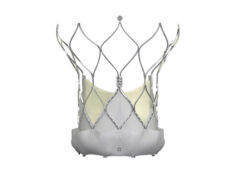
Analysis of data from the TVT registry, looking at the impact of cerebral embolic protection devices on disabling stroke after transcatheter aortic valve implantation (TAVI), demonstrates a “small, borderline significant” reduction in in-hospital disabling stroke, with patients with prior stroke the most likely to benefit from the use of embolic protection devices.
Neel Butala (University of Colorado, Aurora, USA) presented these conclusions during a late-breaking clinical trials and science session at New York Valves (5–7 June, New York, USA), following what was described as the largest analysis to date of outcomes following the use of cerebral embolic protection following TAVI. Findings of the study were also published in Circulation: Cardiovascular Interventions.
Cerebral embolic protection devices are intended to mitigate the risk of stroke during TAVI by capturing and removing debris dislodged during the procedure before it reaches the brain, however their benefit remains unproven.
The largest trial so far to investigate the use of a cerebral embolic protection device, the PROTECTED TAVR trial which assessed Boston Scientific’s Sentinel, found no significant effect on the incidence of periprocedural stroke, but a difference in rates of disabling stroke which favoured the use of cerebral embolic protection.
Using the Society of Thoracic Surgeons (STS) and American College of Cardiology (ACC)-established TVT registry, which monitors patient safety and real-world outcomes related to transcatheter valve replacement and repair procedures performed throughout the USA, Butala and colleagues set out to examine the association between embolic protection device use and a proxy for disabling stroke among transfemoral TAVI patients between 2018 and mid-2023.
Of note, the research showed a steady growth in embolic protection device usage throughout the duration of the study followed by a decline and plateau coinciding with the release of the PROTECTED TAVR trial results. In mid-2023, embolic protection devices were used in 34% of hospitals and 12% of patients, with marked variation between centres, Butala reported.
The primary outcome employed by the investigators was in-hospital disabling stroke—defined as stroke associated with either in-hospital death or discharge to a non-home location.
The investigators evaluated the association between embolic protection device use and disabling stroke using instrumental variable (IV) analysis with site-level preference for embolic protection device use as the instrument—a quasi-experimental approach that can support causal inference. In addition, they performed a propensity-score based comparison using overlap weighting as a secondary analysis.
Within their analysis, Butala and colleagues identified 53,389 patients who received an embolic protection device over the duration of the study, representing 12.9% of the total 414,649 transfemoral TAVI patients treated during that time.
The researchers reported an unadjusted rate of in-hospital disabling stroke of 0.7% among those who received an embolic protection device and 0.9% in those who did not.
Further to this, embolic protection device use was associated with a reduction in disabling stroke in both IV analysis (relative risk [RR]: 0.87; 95% confidence interval [CI]: 0.73–1) and propensity-weighted (PW) analysis (OR 0.79; 95% CI: 0.7–0.9) but was not associated with a reduction in non-disabling stroke. In sub-group analyses, the benefit of embolic protection device use was greater among those with prior stroke than those without (interaction p<0.05 for IV and PW).
“Our prespecified primary analysis using an instrumental variable approach demonstrated a small, borderline significant reduction in in-hospital disabling stroke that is likely to be causal in nature,” Butala told the New York Valves audience, noting that this corresponds to a 13% relative risk reduction and 0.12% absolute risk difference.
Similar findings were found in the secondary (propensity-weighted) analysis, Butala commented, noting that this equates to a 21% relative risk reduction and a 0.19% absolute risk difference.
“These findings are congruent with those from the PROTECTED-TAVR trial and suggest that the reduction in disabling stroke from embolic protection device use is real but the effect size may be relatively small in all-comer patients,” Butala said.
Speaking to Cardiovascular News, Butala highlighted the greater magnitude of effect in patients with prior stroke. “This is the first time anyone has found a subgroup that is more likely to benefit from embolic protection device use,” he said. “This can guide selective use of embolic protection devices in clinical practice as well as future clinical trials for newer devices by identifying a population that might be more likely to show an effect.”
A trial involving more than 7,000 patients is currently underway in the UK—BHF PROTECT-TAVI—which is randomising patients 1:1 to TAVI with or without the Sentinel device, and investigators hope that this will provide definitive evidence as to whether embolic protection should be considered as an important adjunct to TAVI.










